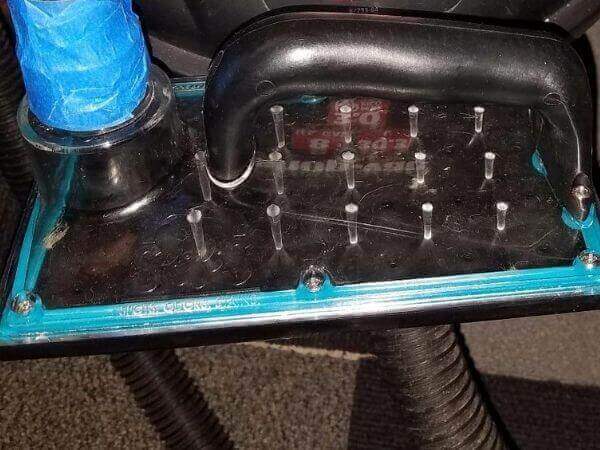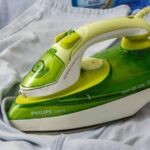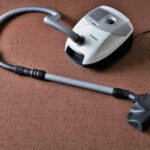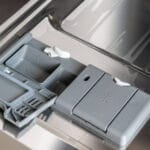With a canister or upright vacuum, routine carpet cleaning seems easy. However, it’s a whole different situation when liquids find their way into the padding and underneath.
First of all, these kind of vacuums cannot come to your rescue. You need a wet and dry vacuum to remove moisture from the carpet fibers.
Secondly, even the most powerful shop vacuums cannot pull moisture from the padding and subfloor. You need additional tools that offer more precision while vacuuming and cleaning. This is where a subsurface carpet extraction tool comes in.
Subsurface Carpet Extraction Tool
A subsurface carpet extraction tool is a machine extension that offers targeted vacuuming. This means that more suction power goes to the area that requires liquid extraction. As such, liquid contaminants are extracted from the carpet fibers, padding and underneath.
The carpet extraction tool is suitable for all kinds of liquid dirt. As a result, you do not have to worry if a glass of water knocks over your carpet. Similarly, there should be less anxiety if your old pet does its thing on your carpeted floor.
It is not only possible to extract the moisture, but also the odor and stains.
How Does the Tool Work?
Ideally, sub surface carpet extraction tool is suitable for spot cleaning. It is not ideal for an entire carpet that is oversaturated with water. All the same, you can use it for big spots by working with a small section at a time.
Step 1: Fit the Tool to the Vacuum’s Hose
The first step for extracting moisture is fitting the tool to the hose your machine. In this case, the machine has to be a powerful shop vacuum. Ideally, your machine’s motor should be 5 HP and above. Results with a less powerful motor, leave a lot to be desired.
Depending on the models of your machine and subsurface extraction tool, you might experience so difficulties while trying to fit the tool to the hose. In this case, you need to get an adapter. This happens even with some tool models that are marketed as suitable for hoses of different sizes.
Step 2: Inspect the Spot
Now that you have the equipment set and ready for the job, it is time to inspect the spot. If your spot is just wet from clean water, you can go ahead with the extraction.
Clean water spots are easy to remove. They do not require prior treatment because they leave a permanent or semi-permanent mark on the carpet.
If a spot is as a result of dirty water, begin by cleaning it with soapy water. Form the solution in a small bowl and apply on the section as you brush off the dirt. Brush off until you remove all the dirt. Finish by rinsing off with clean water.
An alternative approach is to pre-treat the spot with liquid detergent. Still, remember to avoid bleaching agents that can discolor your carpet permanently.
Let the detergent soak, then scrub gently with a brush. Rinse with clean water and saturate it completely. Do not worry if water gets to the padding. The whole purpose of the extraction tool is to pull water from there an underneath.
If the spot is as a result of something like coffee or pet urine, use the right product to pre-treat it. There are different methods for removing different kinds of stains. Some stains also require that you clean with water after soaking them with a stain remover.
Stains resulting from pet waste cause odor that is extremely difficult to remove. As such, it is very important to use a highly efficient pet odor eliminator. The odor eater should deal with most of the mess whereas extraction should help clear the smell completely.
Step 3: Saturate the Spot
It is imperative that you saturate the spot with liquid, to achieve optimal performance with a subsurface extraction. The liquid can be water, a solution of liquid detergent and water, or a stain remover.
Saturation allows the liquid to get to the padding and underneath. Hence, as the extraction process sucks it out, contaminants and bad odor are equally removed.
Step 4: Extract
Place the extraction tool on the spot and turn on your vacuum or extractor. You need to hold the tool on to the surface as all the suction power is directed to the spot. The tool pulls water from the surface within a few minutes.
Work with one spot at a time if you intend to extract water from a relatively large area.
Step 5: Use Fans and a Dehumidifier
The extraction process only helps to remove most of the liquid from your carpet. You cannot rely on it for complete dryness. That said, it is much better than any other carpet cleaning method that is applicable for home cleaning
To keep your carpet completely free from moisture, use fans and a dehumidifier. Alternatively, you can keep the room from clutter and open the windows for air to circulate properly. Ultimately, the carpet will dry on its own.
Step 5: Clean the Tool and Vacuum
After you are done with the cleaning process, it is time to clean the tools as well as the vacuum. Drain the liquid and clean each component with warm soapy water. This step prevents the tool and vacuum from developing bad odor.
Best Alternative for Subsurface Extraction Tool
The idea of at home subsurface extraction is borrowed from professional carpet cleaning. Professional cleaners employ this technique with the use of a Water Claw. A Water Claw is much more powerful. Hence, it is reliable for extracting water from an entire carpet and the subfloor.
In most cases, a Water Claw works with an extractor or truck mount.
Advantages of Subsurface Extraction
Unlike ordinary carpet cleaning and stain removal, you can rely on subsurface extraction for underneath cleaning. This means that the results are much better compared to using a spot and stain cleaner.
With regular spot and stain cleaners, you do not address the root cause of the problem. As such, stains and spots keep reappearing because the problem is with the padding and subfloor.
This not only makes it difficult to maintain good hygiene, but has the potential to damage your carpet and floor permanently.
You also likely to live with pet urine odor lurking from underneath.
A subsurface extraction tool is cost effective. It is incomparable to replacing an entire carpet because of reoccurring stains and permanent pet urine odor.





